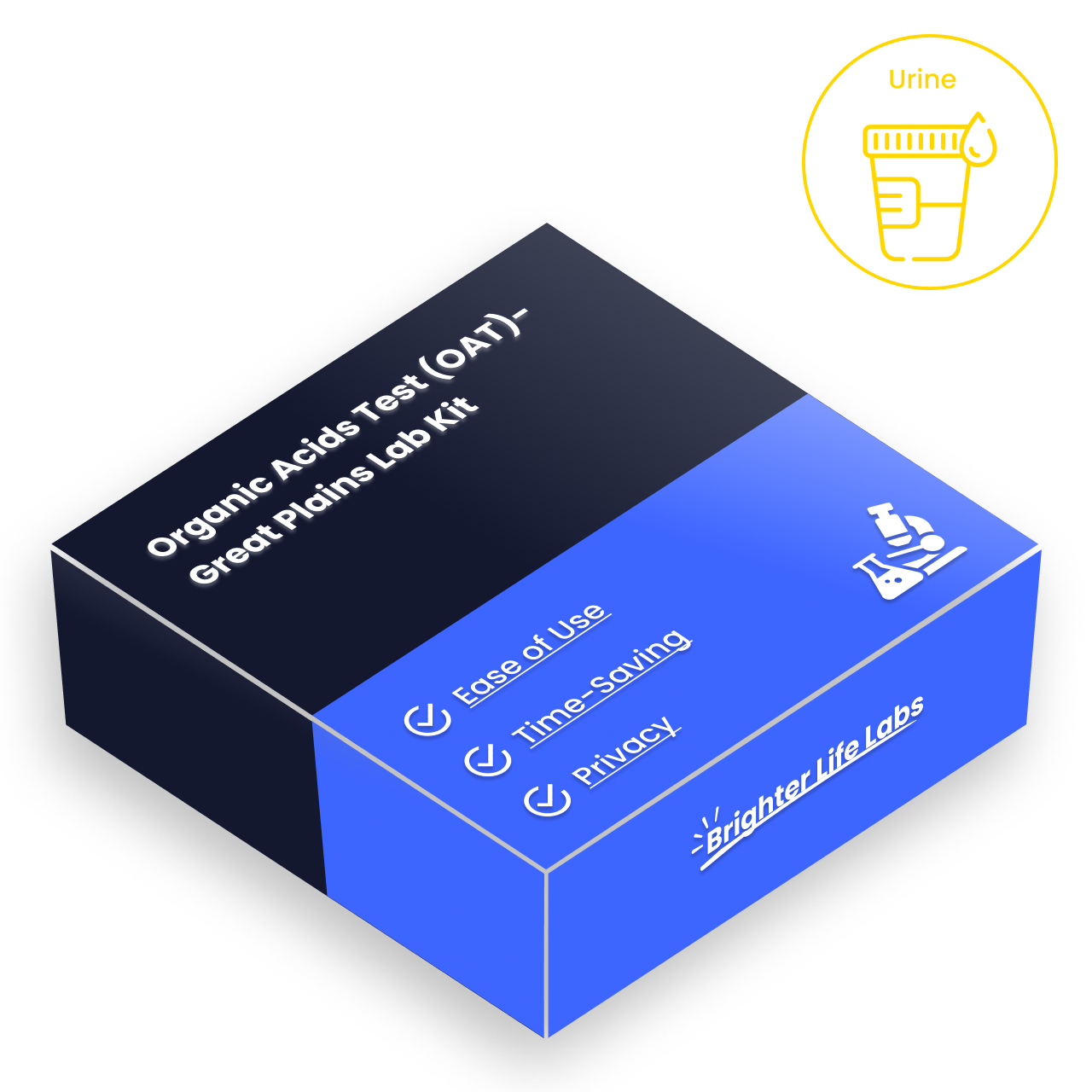1
/
of
1
Mosaic (Great Plains Lab)
Organic Acids Test (OAT)-Great Plains Lab Kit
Organic Acids Test (OAT)-Great Plains Lab Kit
Regular price
$395.00 USD
Regular price
Sale price
$395.00 USD
Unit price
/
per
Shipping calculated at checkout.
Couldn't load pickup availability
Note: This is a home collection test kit that will be mailed to you.
To order this test Internationally, please contact us via email, phone, or chat.
Fasting:
Lab:
Great Plains Lab
Specimen:
Urine
Results:
Average processing time 1-2 weeks
Note: Result turnaround times are an estimate and are not guaranteed. Our reference lab may need additional time due to weather, holidays, confirmation/repeat testing, or equipment maintenance.
Special Instructions:
Patient must avoid apples, grapes (including raisins), pears, cranberries and their juices 24 hours prior to specimen collection. Avoid arabinogalactan, echinacea, reishi mushrooms, and ribose supplements for 12 hours before collection. Collect the first morning urine in the collection cup provided. Collecting sample prior to eating or drinking is preferred. Freeze urine specimen for a minimum of 4 hours before shipping. Keep in freezer until ready to ship. Ship with frozen gel pack (included). Send the sample Monday through Thursday only. Do not collect during menstrual cycle. Limit liquid intake starting at 6pm the night prior to collection to avoid sample dilution. Urine must be yellow in color. If urine is clear the sample is too diluted. Discard diluted sample, rinse the collection cup in hot water only (no soap), air dry, then re-collect.
Description:
Organic acids are chemical compounds excreted in the urine of mammals that are products of metabolism. Metabolism is the sum of chemical reactions in living beings by which the body builds new molecules and breaks down molecules to eliminate waste products and produce energy. Organic acids are organic compounds that are acidic. Organic acids are substances in which carbon and hydrogen are always present but which may also contain the elements of oxygen, nitrogen, sulfur, and phosphorus as well. The names of most organic acids contain the suffix –ic, followed by the word “acid” such as lactic acid. Every organic acid has one or more conjugate bases named with the suffix –ate. Thus, the conjugate base of lactic acid is lactate. Many times, the name of the organic acid and its conjugate base(s) are used interchangeably when discussing physiology and biochemistry, such as lactate or lactic acid. The most common chemical groups associated with organic acids are carboxylic acids which are present in the conjugate base form at neutral pH, 7.0, the pH of the inside of most living cells. Organic acids with one carboxylic acid have one conjugate base while some organic acids may have two or three carboxylic acids and two or three conjugate bases. Many genetic disorders are caused by the production of an inefficient enzyme that reacts at a slower than usual rate, resulting in an accumulation of a metabolic intermediate. More than 50 phenotypically different organic acidemias are now known since the oldest known disease, isovaleric acidemia, was described in 1966. An organic acid is any compound that generates protons at the prevailing pH of human blood. Although some organic acidemias result in lowered blood pH, other organic acidemias are associated with organic acids that are relatively weak and do not typically cause acidosis. Organic acidemias are disorders of intermediary metabolism that lead to the accumulation of toxic compounds that derange multiple intracellular biochemical pathways including glucose catabolism (glycolysis), glucose synthesis (gluconeogenesis), amino acid and ammonia metabolism, purine and pyrimidine metabolism, and fat metabolism. The accumulation of an organic acid in cells and fluids (plasma, cerebrospinal fluid, or urine) leads to a disease called organic acidemia or organic aciduria.
Includes:
Organic Acids Test (OAT) • Citramalic • • 5-Hydroxymethyl-2-furoic • 3-Oxoglutaric • Furan-2,5-dicarboxylic • Furancarbonylglycine • Tartaric • Arabinose • Carboxycitric • Tricarballylic • 2-Hydroxyphenylacetic • 4-Hydroxyphenylacetic • 4-Hydroxybenzoic • 4-Hydroxyhippuric • Hippuric • 3-Indoleacetic • Succinic • HPHPA (Clostridia marker) • 4-Cresol (C. difficile) • DHPPA (beneficial bacteria) • Glyceric • Glycolic • Oxalic • Lactic • Pyruvic • 2-Hydroxybutyric • Fumaric • Malic • 2-Oxoglutaric • Aconitic • Citric • Homovanillic Acid (HVA) • Vanillmandelic Acid (VMA) • HVA/VMA Ratio • 5-Hydroxyindoleacetic (5-HIAA) • Quinolinic • Kynurenic • HVA/DOPAC Ratio • Dihydroxyphenylacetic (DOPAC • Uracil • Thymine • 3-Hydroxybutyric • Acetoacetic • 4-Hydroxybutyric • Ethylmalonic • Methylsuccinic • Adipic • Suberic • Sebacic • Methylmalonic (Vitamin B12) • Pyridoxic (Vitamin B6) • Pantothenic (Vitamin B5) • Glutaric (Vitamin B2-Riboflavin) • Ascorbic (Vitamin C) • 3-Hydroxy-3-methylglutaric (Vitamin Q10-CoQ10) • N-Acetylcysteine (Glutathione precursor and chelating agent) • Methylcitric (Vitamin H-Biotin) • Pyroglutamic • Orotic • 2-Hydroxyhippuric • 2-Hydroxyisovaleric • 2-Oxoisovaleric • 3-Methyl-2-oxovaleric • 2-Hydroxyisocaproic • 2-Oxoisocaproic • 2-Oxo-4-methiolbutyric • Mandelic • Phenyllactic • Phenylpyruvic • Homogentisic • 4-Hydroxyphenyllactic • N-Acetylaspartic • Malonic • 3-Methylglutaric • 3-Hydroxyglutaric • 3-Methylglutaconic • Phosphoric
Share


